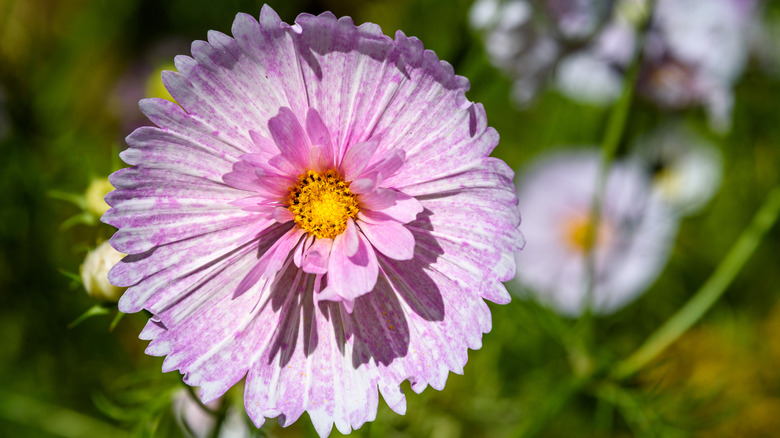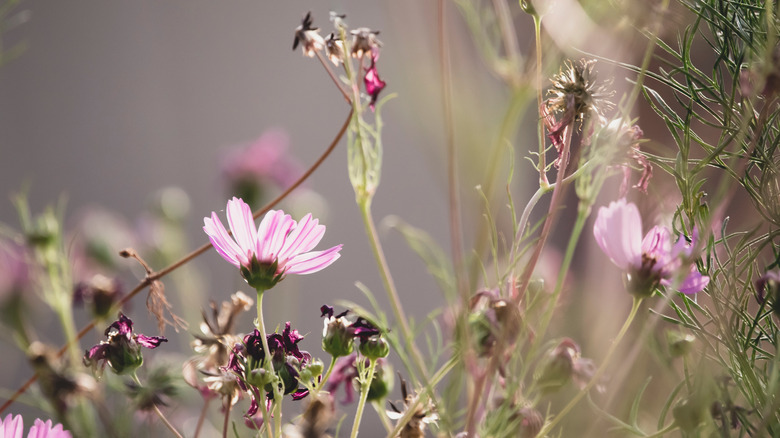After a long winter, we are all ready to bring color back into our gardens with some bright flowers. This spring, you should consider growing cosmos flowers. Standing on thin green stems, featuring plenty of petals in an array of colors, Cosmos bipinnatus and Cosmos sulphureus are flowering annual plants that grow easily during the warm spring and summer months, according to The Spruce.
The two common species of cosmos flowers grown in the United States can be difficult to tell apart if you don’t know much about them. C. bipinnatus looks a lot like daisies. They normally are found in the colors pink, white, red, and sometimes orange, and they may become up to 4 feet tall. These cosmos flowers usually begin to branch once they mature.
C. sulphureus is taller than its sibling, reaching a height of 6 feet in ideal conditions. They are almost always yellow in color, but some varieties lean toward orange. Both species are native to Mexico, as per Gardening Know How, and this makes them lovers of hot weather and quite drought-tolerant.
How to use cosmos flowers in the garden

Most often, cosmos flowers love being planted in the garden. They enjoy full sun and minimal amounts of water. They do need warm weather to survive, so don’t try planting these when there is still snow outside. During the summer, cosmos flowers grow rapidly as annuals in USDA zones 2 through 11, as shown by All About Gardening.
Keep in mind that these gorgeous flowers are prolific for their self-sowing abilities. Because of this, for people living in climates where cosmos can easily spread and take over such as Florida, Georgia, and Alabama, per the USDA, it’s best to plant your cosmos flowers in pots instead of in the garden.
Outside of this area, many gardeners love planting their cosmos flowers in large garden beds with other brightly colored flowers. According to Almanac, cosmos flowers are best paired with other annuals such as asters, poppies, and cleomes. If you prefer dwarf varieties of cosmos flowers, shorter companion plants such as pansies, zinnias, and Johnny jump-ups may be up your alley.
How to grow cosmos flowers

Growing cosmos flowers takes no effort. All you need is not-too-rich well-draining soil, some cosmos seeds, and plenty of space for them to grow. We say “not-too-rich soil” because cosmos flowers do best in neutral to poor soil, as explained by Florgeous. Rich soil will cause the flowers to grow too tall too fast, causing them to fall over. You can buy cosmos seeds at your local nursery or grocery store, but for free you can propagate your own instead.
There are two ways to propagate cosmos flowers. Collecting seeds is the easiest method. Simply wait for all the petals to fall off your cosmos flowers. Once the heads are dry you can simply rub your finger across the head to dislodge them. Gardening Know How suggests cracking the pods with your fingernails to make sure all are harvested. Put your seeds into an envelope until you are ready to plant them in the spring.
You may also propagate from cuttings, as per The Spruce. Start by cutting off a 3-inch stem from a branching cosmos flower just under a leaf node. Then, pick off the extra leaves with your fingers. Place the stem into a small container of potting soil, first pressing a hole for it to go into with your finger. Firm the soil around the stem, and water it generously. In a few weeks, it should grow roots and new leaves.
How to care for cosmos flowers

Uladzimir Tsarou/Shutterstock
Caring for cosmos flowers is easy, explains Gardening Know How. These are low-maintenance, drought-tolerant, and neglect-tolerant plants. As long as you give them some good growing conditions to start, you shouldn’t have to do anything but some light pruning for the rest of the summer. Cosmos flowers’ only requirement is full, direct sunlight for at least eight hours each day, as told by All About Gardening. Without a good source of sunlight, there’s a good chance your flowers will become sad and not bloom as beautifully as you’d want them to. Though they can withstand some shade, it’s in your best interest to plant them in the sunniest part of your yard.
Cosmos flowers only need water when they are first planted, says Almanac. Young cosmos need this to establish themselves and to begin growing properly. Once that time has passed, they won’t need you to water them at all. They can get all the hydration they need from rainwater. Although, you should be careful if you live in a particularly rainy area such as the Pacific Northwest. Too much water, even from the rain, can harm your cosmos flowers.
Cosmos flower varieties

knelson20/Shutterstock
In the Cosmos genus, there are more than 30 different species, according to Gardener’s Path. The three most popular species C. bipinnatus, C. sulphureus, and C. atrosanguineus are all native to Mexico but naturalized in many parts of the United States and Canada as well as some areas of Europe. Each of the species has a handful of beautiful cultivars that widely vary in color and looks. Some varieties you may find difficult to recognize as cosmos at all.
-
C. sulphureus “Bright Lights” appear yellow, gold, and scarlet. They feature semi-double blooms and may grow up to 3 feet tall.
-
C. sulphureus “Diablo” has red, orange, and white-hued flowers that give them a fiery look. They are slightly taller than “Bright Lights” reaching 4 to 5 feet tall on average.
-
C. bipinnatus “Apricot Lemonade” is an award-winning variety, characterized by peachy petals.
-
C. bipinnatus “Candy Stripe” features bi-colored petals normally in white and pink. Like most bipinnatus varieties, it can reach up to 6 feet tall.
-
C. bipinnatus ” Cupcakes and Saucers” is a variety of cosmos flowers that you have to see to believe. They look like they are straight out of a fairytale with large pink or white blooms shaped like cupcake wrappers filled with smaller petals of the same color.
-
C. atrosanguineus “Choca Mocha” is a cultivar that has chocolatey-red petals that smell exactly as the name suggests. Darkly colored cosmos flowers are few and far between, except in the atrosanguineus species.
How to repot cosmos flowers

ForestSeasons/Shutterstock
To repot cosmos flowers, you’ll need well-draining potting soil and a large self-draining pot. You might also want one or more plant support hoops to keep your potted cosmo flowers upright if they’ve grown quite tall. Repotting cosmos flowers can be tricky due to their size. That’s probably why they are so often grown in the garden. The Spruce tells us that you should only grow one cosmos flower per one gallon of container space. This means if you want a bunch of cosmos you’re going to need a very large pot.
When you begin the process of repotting your cosmos flowers, consider asking a friend for help. It will likely take one person to flip the container and another to dislodge the flowers. Once your cosmos are out of their old pot, use a gardening fork to dislodge all the excess soil. As soon as their root ball is adequately exposed, place the cosmos into their new pot and backfill them with fresh, well-draining potting soil. According to Gardening Know How, you should be picky about the kind of soil you use with cosmos flowers. Regular gardening soil will not do the trick, you need a general-purpose potting mix that will ensure proper drainage. Pack this dirt firmly onto the top of your cosmos flower’s roots. Finally, water your flowers generously before putting them in a sunny spot.
Pest and problems of cosmos flowers

Cavan-Images/Shutterstock
A few pests can easily affect your cosmos flowers’ health. The worst of them are aphids and slugs, as per Gardenia. While aphids can usually be dealt with by spraying some neem oil on your plants, getting rid of slugs can be a bit more tricky. Many expert gardeners suggest using natural slug repellents such as abrasives or slug traps, as explained by Better Homes & Gardens.
Aster yellows disease and powdery mildew on cosmos flowers are two things All About Gardening warns us about. Aster yellows is the worst of the two. Your plants can contract this disease from small grasshopper-like insects called leafhoppers. They transfer a pathogen when eating the leaves of these flowers that will cause them to yellow and die. The disease cannot be cured and you must burn or bury any flowers that contract it. Powdery mildew is a bit less frightening and not as deadly. To avoid it, you should put plenty of space between your flowers when planting them. By giving your cosmos flowers plenty of sunlight and very little water, they should overcome the disease in time.



